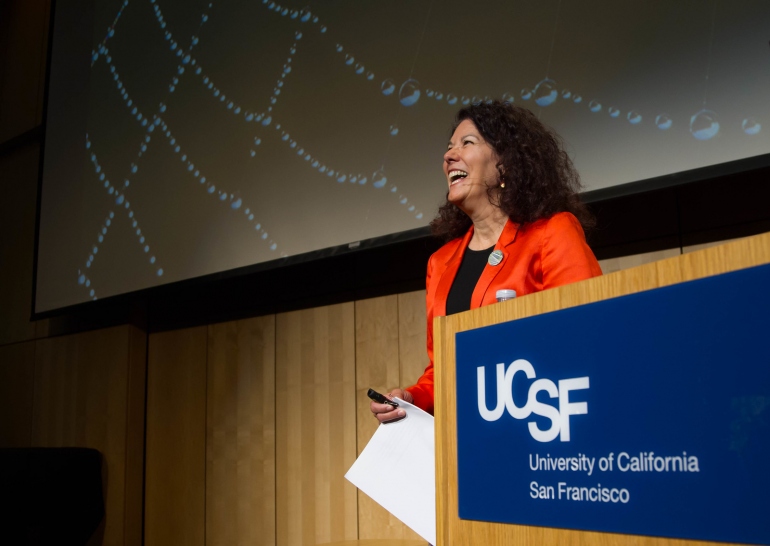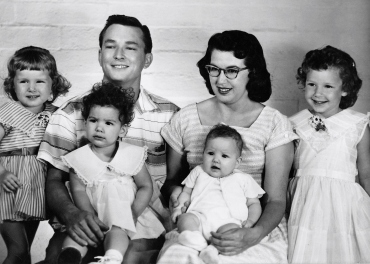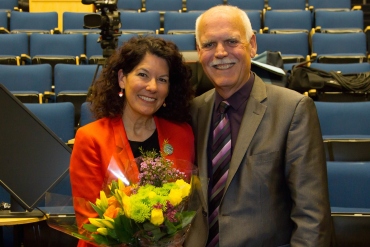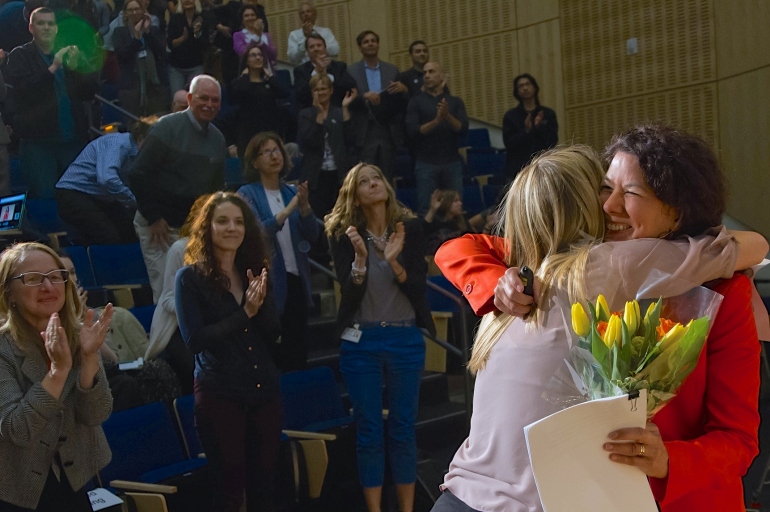Kimberly Topp: A Life of Humility and Gratitude
Physical Therapy Chair Delivers Touching 'Last Lecture' to Close Out UCSF's Academic Year

UCSF students chose Kimberly Topp, PhD, to deliver this year's "Last Lecture" at Cole Hall. Photo by Susan Merrell
The world Kimberly Topp, PhD, was born into in the 1950s had a narrow view of what she should aspire to be. Toys marketed to girls at the time revolved around some variation of kitchen appliances. Fortunately for Topp, her parents were forward thinking nurturers who encouraged her to try new things.
And so began Topp’s “last lecture,” an annual tradition where UC San Francisco students choose a professor whom they want to answer the question: “If you have one lecture to give, what would you say?”
Topp, professor and chair of Physical Therapy and Rehabilitation Science, spoke of humble beginnings growing up as a shy girl in Phoenix, Arizona, near a duck farm.
She said she was born on the year Disneyland opened its doors in Anaheim. She invited the audience to “Google it” if they didn’t know the answer. (The year was 1955.)
Sprinkling humor into the narrative of her life, Topp fondly recalled visits to the local petting zoo, which featured gumball machines filled with Trix cereal. This meant you could “feed it to the goats or yourself.” And an underdeveloped irrigation system – which was common at the time – meant her family home “had a lake every two weeks” whenever it rained.
Unconditional Love
Topp spoke fondly of her parents: her mother – a homemaker – who made dresses for her four daughters while teaching them how to write, and her father – a Navy Korean War veteran turned graphic artist – who took his family camping, while instilling in them the value of self-sufficiency and love of nature. Most importantly she learned about unconditional love from both parents.

Topp's family includes, from left, sister Leslie, father James, Topp on father's lap, mother Frances, sister Nancy on mother's lap, and sister Bonnie. Photo courtesy of Kimberly Topp
Charity work played an important role during Topp's upbringing. She worked with migrant workers, and ran errands for a disabled woman who was unable to leave her home. Occasionally Topp had to pick out a toy from her collection to give to less fortunate children.
After eighth grade, she worked full time babysitting, cleaning, cooking and ironing for various families. She also tended to horses, chickens and rabbits when her family moved from Phoenix to the more rural Flagstaff. Her father designed and built their home and his daughters helped with some of the minor construction projects.
In high school Topp worked 40+ hours working retail, becoming an assistant manager before graduation. Juggling school and work taught her valuable life skills such as responsibility and following through on a project.
Change and Perseverance
As she began to realize a career in retail wasn’t for her, Topp met her future husband Bruce who was a police officer at the time. She describes him as “kind, generous, creative, funny, gutsy and patient.”
Shortly after, Topp enrolled in Northern Arizona University’s physical therapy program. She saw this as an opportunity to apply her parents’ teachings of helping others. This is where she learned to embrace change and learn about perseverance. She challenged herself and sought out opportunities for growth.
A defining moment for her was working with a 22-year-old patient, a competitive water skier who lost control while going 106 mph. Topp learned to connect with the patient, helping her get through functional impairment issues.
“This was the moment I was hooked,” Topp said. “I became committed to helping patients get better so they could lead amazing lives.”
She eventually married Bruce, who in 1984 completed his PhD in educational psychology from Arizona State University in 18 months – Topp said with pride – and then started working for Lockheed. After working as a physical therapist for several years, Topp enrolled in UC Davis’ PhD program in anatomy and cell biology, graduating in 1990. She then completed her postdoctoral fellowship in neurobiology at UCSF in 1993.
Focus and Passion
During this hectic period in their lives, Topp and Bruce sometimes lived apart due to competing work and school commitments. At one point they lived on a 35-ft. sailboat that had 200 sq. ft. of living space.

Topp and her husband Bruce share a love of aquatic adventures that dates back to the early days of their marriage. Photo courtesy of Kimberly Topp

Bruce and Kimberly Topp have loved and supported each other through more than three decades of marriage. Photo by Susan Merrell
Topp opts for a minimalist approach and prefers small spaces. During her time as a UCSF faculty member, she has inhabited space as small as 185 sq. ft. and as large as 1,500 sq. ft. She believes teaching and learning spaces should drive learning forward for the educator and student. She also believes research spaces need to facilitate creativity and collaboration.
She had many wonderful mentors in her career. One in particular stands out. Hugh “Pat” Patterson, PhD, a human anatomy professor, taught Topp to be a “focused and passionate teacher.” Those lessons have carried her throughout her teaching career. She also says some of her best teachers have been her students.
Topp ended her last lecture by encouraging audience members to “mind the rumble strip,” a reminder to get back on course. The rumble strip is literally a ridged section at the edge of some roads that causes vibration inside the car if the driver gets off course. She first heard about “minding the rumble strip” from Vice Dean for Education Catherine Lucey.
“To me, in the context of our current discussions about inclusion and diversity, we should be open to external cues from others and feel the cues internally to correct our course or behavior,” Topp said. “I ask that we create a culture at UCSF that facilitates open conversations about diversity, without judgment or grudges, without defensiveness or disrespect. We can only change ourselves, so ‘rumble strip’ reminders from others in open and respectful conversations will enable us to learn and modify our own behaviors to be more understanding and inclusive.”
Topp has lived her life guided by the tenets her parents instilled in her: unconditional love, hard work and helping those less fortunate.
By the genuine outpouring of support she received throughout the evening from the audience, Topp’s understated yet heartfelt last lecture – and the way in which she lives her life – resonated with many who attended.
For more internal-facing stories from the UCSF community, please visit Pulse of UCSF.
We are driven by the idea that when the best research, the best education and the best patient care converge, great breakthroughs are achieved. We pursue this excellence through our people. We are all UCSF, united by a driving passion to solve the most challenging health issues of our time and to redefine what's possible. Join the conversation at www.ucsf.edu/oneUCSF.

Emcee and graduating physical therapy student Erin Carlson hugs Topp at the end of the last lecture, as the audience gives Topp a standing ovation. Photo by Susan Merrell